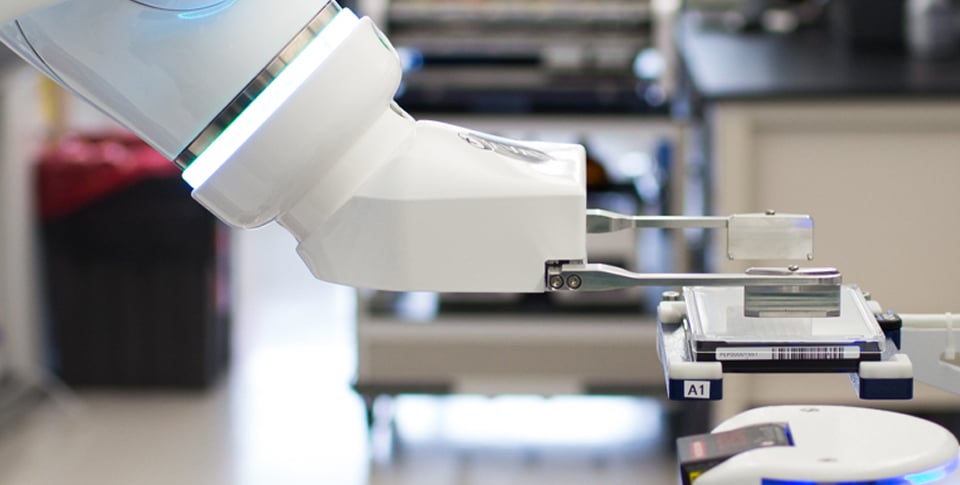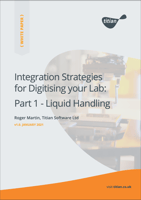While companies can work remotely - and have had to adapt working during the COVID-19 pandemic - most drug discovery research projects need to be completed in a laboratory. Samples that are collected in the field can be more difficult to obtain remotely. Different tests require access to a variety of substances in varying volumes and a range of labware types that need to be properly disposed of after use - these are manual processes! Most lab instruments are not portable and also require manual handling and maintenance.
Although some labs have automated many of their liquid handling processes (amongst others) to digitise workflow control and data capture, this process has been lead by the large pharmaceutical companies as it requires substantial investment and a lot of time and planning to get right.

However, more recently, there has been a growing movement to digitalise processes as a way to address the increasing complexity of modern laboratories. Digitised data flows bring together fragmented processes and allow collaborations across teams and organisations. The integration of lab instruments and software allows real-time tracking of data, leading to more control and faster responses in the research cycle. It also makes experiments more repeatable, due to better tracking of what was done in initial experiments. This enables an experiment in one lab to be reliably repeated on the other side of the world.
People have become less apprehensive about accessing and sharing information remotely through the cloud, thanks to increasing standards of security and different secure options for accessing information.
While lab information management system (LIMS) are nothing new, they have become a central platform for enabling laboratories to bring together many parts of everyday work. The COVID-19 pandemic has accelerated this process of digitalisation.
The benefits of lab digitalisation:
The benefits of lab digitalisation vary based on the different approaches taken as well as the goals that an organisation is trying to accomplish.
Some of the common benefits achieved are:
- Increased accuracy of documentation for more efficient research
- Decision making is facilitated by the insight provided by accurate data sources
- Increased collaboration through combining, sharing and updating datasets
- Increased security with data protected by access control
- Simplified workflows through automation while enhancing lab operations
- Increased traceability with comprehensive audit trails
- Better defined key performance indicators (KPIs) for laboratory projects and processes
- Reduced human error through automating repetitive tasks
- Freeing up experts time for benchwork and research
- More sustainable processes as digitalisation can help reduce lab waste
- An overall increase in productivity and speed of operations
If you’re interested in learning more about how to integrate and digitise your lab, download our white paper: Integration Strategies for Digitising your Lab - Part 1: Liquid Handling. Read it here!
What’s next for the Lab of the Future?
User experience improvements such as AR and voice recognition
This involves streamlining workflows and introducing ‘touchless’ processes that avoid researchers having to remove their gloves or interrupt experiments to capture data points. In time, this will make lab processes quicker and easier.
The Internet of Things (IOT)
IOT and internet-connected objects in the lab are increasing the capacity to collect and transfer data more easily and more rapidly.
AI
Artificial Intelligent (AI) is advancing all the time, with machine learning and future AI initiatives set to become a part of every laboratory. Although still in their infancy, this will help to integrate data from many different sources which will encourage standardisation and will enable communication between automated lab instruments.
Acceleration of the current integration trends
A key trend is to integrate and optimise ELN, LIMS and sample management software, designed with collaboration in mind. This includes:
- seamless management of data, keeping an audit trail of all changes
- improved workflow management across devices and instruments
- the need for off the shelf integrations between different systems
Titian Software plays an important role in helping this acceleration thanks to its Mosaic sample management platform forming one of the 'integration hubs' enabling the digitalisation of laboratory workflows.
Digitalisation is fast becoming the norm in labs around the world. Soon, it won’t be an option but something that needs to be considered. Every lab is at a different stage of digital maturity, but we can all start to see the benefits and how it will soon affect our own operations.
Titian is producing a series of articles related to the different aspects of digitalisation drawing on our experience as an integration hub. As part of this, we have released a white paper "Integration Strategies for Digitising your Lab".
 The first part of our white paper describes the different levels of integration available for liquid handling instruments. It explains the pros and cons of these for handling the data stream provided by these instruments.
The first part of our white paper describes the different levels of integration available for liquid handling instruments. It explains the pros and cons of these for handling the data stream provided by these instruments.
